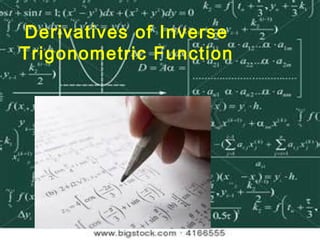4.3 derivatives of inv erse trig. functions
•Transferir como PPT, PDF•
1 gostou•282 visualizações
Denunciar
Compartilhar
Denunciar
Compartilhar

Recomendados
Recomendados
Mais conteúdo relacionado
Mais procurados
Mais procurados (20)
Limit & Derivative Problems by ANURAG TYAGI CLASSES (ATC)

Limit & Derivative Problems by ANURAG TYAGI CLASSES (ATC)
Application of partial derivatives with two variables

Application of partial derivatives with two variables
Applied Calculus: Continuity and Discontinuity of Function

Applied Calculus: Continuity and Discontinuity of Function
Limit, Continuity and Differentiability for JEE Main 2014

Limit, Continuity and Differentiability for JEE Main 2014
Basic Calculus 11 - Derivatives and Differentiation Rules

Basic Calculus 11 - Derivatives and Differentiation Rules
Lesson 1: Functions and their representations (slides)

Lesson 1: Functions and their representations (slides)
Semelhante a 4.3 derivatives of inv erse trig. functions
In this paper, the Frechet differentiation of functions on Banach space was reviewed. We also investigated that it is algebraic properties and its relation by applying the concept to the inverse function theorem of the ordinary differential equations. To achieve the feat, some important results were considered which finally concluded that the Frechet derivative can extensively be useful in the study of ordinary differential equations.On Frechet Derivatives with Application to the Inverse Function Theorem of Or...

On Frechet Derivatives with Application to the Inverse Function Theorem of Or...BRNSS Publication Hub
Semelhante a 4.3 derivatives of inv erse trig. functions (19)
Calculus 1 Lecture Notes (Functions and Their Graphs)

Calculus 1 Lecture Notes (Functions and Their Graphs)
Lesson 1: Functions and their representations (slides)

Lesson 1: Functions and their representations (slides)
GATE Engineering Maths : Limit, Continuity and Differentiability

GATE Engineering Maths : Limit, Continuity and Differentiability
5.1 Defining and visualizing functions. A handout.

5.1 Defining and visualizing functions. A handout.
On Frechet Derivatives with Application to the Inverse Function Theorem of Or...

On Frechet Derivatives with Application to the Inverse Function Theorem of Or...
Mais de dicosmo178
Mais de dicosmo178 (20)
6.5 & 6.6 & 6.9 the definite integral and the fundemental theorem of calculus...

6.5 & 6.6 & 6.9 the definite integral and the fundemental theorem of calculus...
4.3 derivatives of inv erse trig. functions
- 1. Derivatives of Inverse Trigonometric Function
- 2. Inverse Trig Functions Some trig functions domains’ have to be restricted in order for them to have an inverse function – why? Only functions that are 1-to-1 can have inverse functions
- 5. Find dy dx If y = sin −1 ( x 3 ) dy 1 = ×( 3x 2 ) dx 3 2 1− ( x ) therefore 3x 2 ) ( dy = dx 3 2 1− ( x )
- 6. One more example Find dy dx dy = dx e x y = sec−1 ( e x ) if 1 (e ) x 2 −1 dy 1 = dx e 2 x −1 ×( e x )
- 7. Differentiability of Inverse Functions If f(x) is differentiable on an interval I, one may wonder whether f-1(x) is also differentiable? The answer to this question hinges on f'(x) being equal to 0 or not . Indeed, if for any , then f-1(x) is also differentiable. Moreover we have Using Leibniz's notation, the above formula becomes which is easy to remember.
- 8. Example: Confirm Differentiability of Inverse Function formula for the function f (x) = x 3 +1 Solution: y = x 3 +1 x = y3 +1 y = x −1 3 x = 3 y −1 f −1 (y) = 3 y −1 dy d 3 = x + 1 = 3x 2 dx dx and 1 2 dx d 3 d 1 − = y − 1 = ( y − 1) 3 = ( y − 1) 3 dy 3 dy dy ( ) 2 2 dy 1 3 y−1 = 3 y−1 3 = =3 ( ) dx dx dy
- 9. MONOTONIC FUNCTIONS: Suppose that the domain of a function f is on an open interval I on which f’(x) > 0 or on which f’(x) < 0. Then f is one-to-one, f-1(x) is differentiable at all values of x in the range of f. Example: Consider the function f (x) = x 5 + x +1 Solution: f '(x) = 5x 4 +1 Since f’(x) > 0 on the entire domain, f(x) is monotonic, therefore it has an inverse .Show that f(x) is one-to=one function.
- 10. MONOTONIC FUNCTIONS: Suppose that the domain of a function f is on an open interval I on which f’(x) > 0 or on which f’(x) < 0. Then f is one-to-one, f-1(x) is differentiable at all values of x in the range of f. Example: Consider the function f (x) = x 5 + x +1 Solution: f '(x) = 5x 4 +1 Since f’(x) > 0 on the entire domain, f(x) is monotonic, therefore it has an inverse .Show that f(x) is one-to=one function.